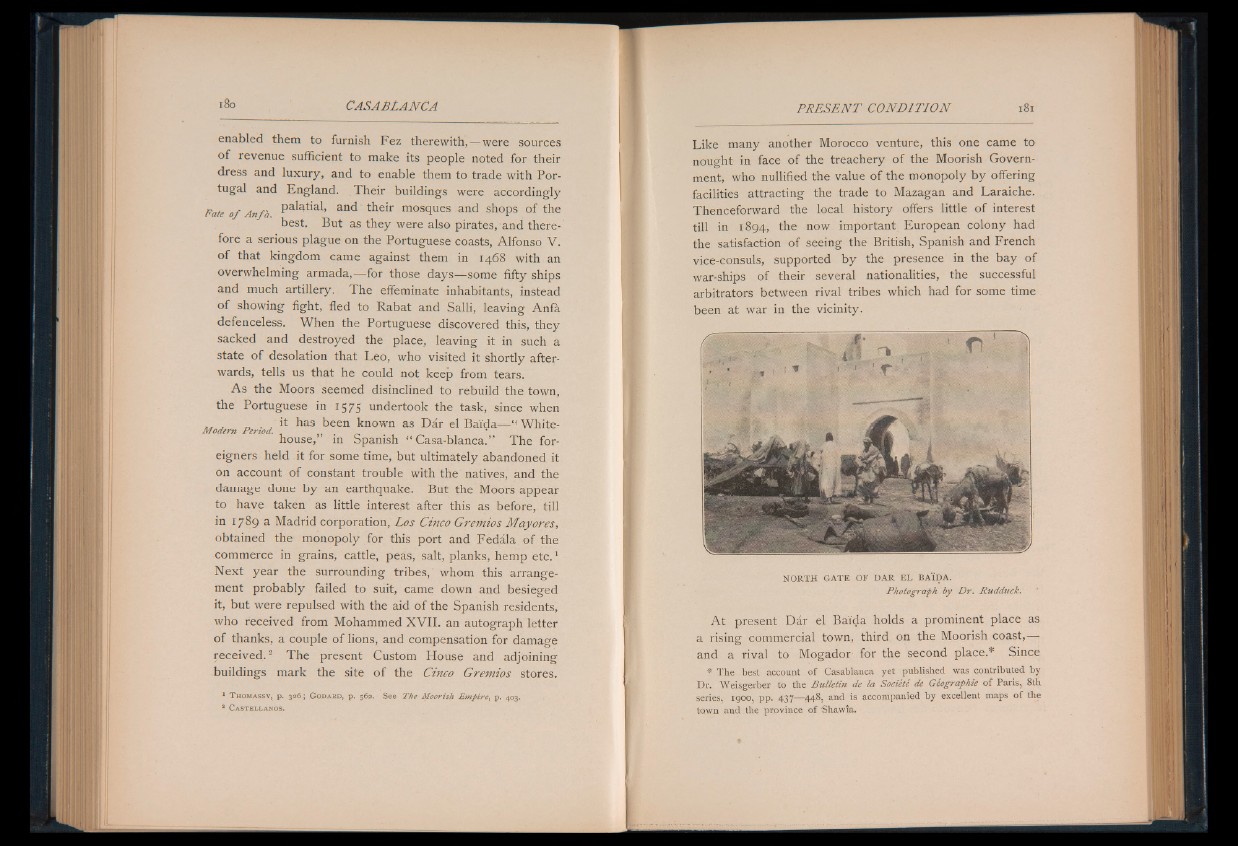
CASABLANCA
enabled them to furnish Fez therewith, — were sources
o f revenue sufficient to make its people noted for their
dress and luxury, and to enable them to trade with Portugal
and England. Their buildings were accordingly
Fate of Anfh P^a$ai» an<^ t^ieir mosques and shops of the
best. But as they were also pirates, and therefore
a serious plague on the Portuguese coasts, Alfonso V.
of that kingdom came against them in 1468 with an
overwhelming armada,— for those days— some fifty ships
and much artillery. The effeminate inhabitants, instead
of showing fight, fled to Rabat and Salli, leaving Anfa
defenceless. When the Portuguese discovered this, they
sacked and destroyed the place, leaving it in such a
state of desolation that Leo, who visited it shortly afterwards,
tells us that he could not keep from tears.
A s the Moors seemed disinclined to rebuild the town,
the Portuguese in 1575 undertook the task, since when
, ' . i t has been known as Dar el Baida— “ White- Modem Pertod.
house, in Spanish “ Casa-blanca.” The for-
eigners held it for some time, but ultimately abandoned it
on account of constant trouble with the natives, and the
damage done by an earthquake. But the Moors appear
to have taken as little interest after this as before, till
in 1789 a Madrid corporation, Los Cinco Gremios May ores,
obtained the monopoly for this port and Fedala of the
commerce in grains, cattle, peas, salt, planks, hemp e tc .1
Next year the surrounding tribes, whom this arrangement
probably failed to suit, came down and besieged
it, but were repulsed with the aid o f the Spanish residents,
who received from Mohammed XVII. an autograph letter
of thanks, a couple of lions, and compensation for damage
received.2 The present Custom House and adjoining
buildings mark the site o f the Cinco Gremios stores.
1 T h om a s s y , p . 3 2 6 ; G o d a r d , p . 562. See The Moorish Empire, p . 403.
2 C a s t e l l a n o s .
PRE SENT CONDITION 181
Like many another Morocco venture, this one came to
nought in face of the treachery of the Moorish Government,
who nullified the value of the monopoly by offering
facilities attracting the trade to Mazagan and Laraiche.
Thenceforward the local history offers little of interest
till in 1894, the now important European colony had
the satisfaction of seeing the British, Spanish and French
vice-consuls, supported by the presence in the bay of
war-ships of their several nationalities, the successful
arbitrators between rival tribes which had for some time
been at war in the vicinity.
N OR TH G A T E OF D A R EL BA ÏDA.
Photograph by Dr. Rudduck.
A t present Dar el Baida holds a prominent place as
a rising commercial town, third on the Moorish coast,—
and a rival to Mogador for the second place.* Since
The best account of Casablanca yet published was contributed by
Dr. Weisgerber to the Bulletin de la Société de Géographie of Paris, 8th
series, 1900, pp. 437— 448, and is accompanied by excellent maps of the
town and the province of Shawia.